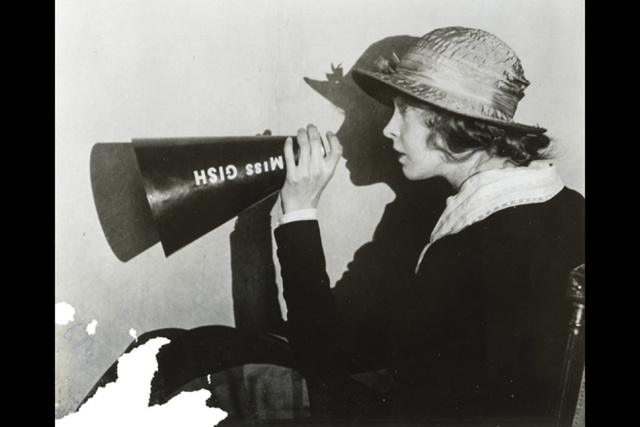by
Mark Garrett Cooper
In 1920, Lillian Gish both delivered a landmark performance in D.W. Griffith’s Way Down East and directed her sister Dorothy in Remodelling Her Husband. This was her sole director credit in a career as a screen actor that began with An Unseen Enemy in 1912 and ended with The Whales of August in 1987. Personal correspondence examined by biographer Charles Affron shows that Gish lobbied Griffith for the opportunity to direct and approached the task with enthusiasm. In 1920, in Motion Picture Magazine, however, Gish offered the following assessment of her experience: “There are people born to rule and there are people born to be subservient. I am of the latter order. I just love to be subservient, to be told what to do” (102). One might imagine that she discovered a merely personal kink. In a Photoplay interview that same year, however, she extended her opinion to encompass all women and in doing so slighted Lois Weber, one of Hollywood’s most productive directors. “I am not strong enough” to direct, Gish told Photoplay, “I doubt if any woman is. I understand now why Lois Weber was always ill after a picture” (29). What should historical criticism do with such evidence?
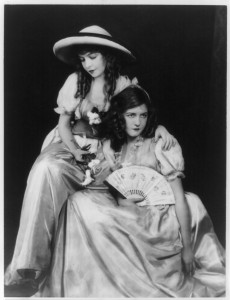
Lillian (left) and Dorothy Gish. Courtesy of the Library of Congress.
By far the most common approach has been to argue that Gish did not really mean what the press quotes her as saying. Alley Acker, for instance, urges us not to be fooled by Gish’s “Victorian modesty” and goes on to provide evidence of her authority on the set (62). Similarly, Affron argues that Gish’s assertions of subservience were partly self-serving. Self-effacement contributed to her star persona as “D.W. Griffith’s virginal, ethereal muse” (15). Gish cultivated this image throughout her career, and Affron finds it exemplified by the oft-repeated story of her masochistic performance in Way Down East’s 1920 ice floe rescue. A different Gish surfaces in an interview with Anthony Slide first published in 1970. There we encounter a decisive and resourceful woman who surmounted extraordinary practical difficulties in directing Remodelling Her Husband. In addition to directing, Griffith gave her the job of supervising completion of a new studio in Mamaroneck, New York. Neither subservience nor modesty inflect Gish’s assessment of the results: “We finished at 58 thousand dollars, and it made, I think, ten times what it cost, which not many films do today” (Slide 1977, 124). Gish also told Slide that she had wanted to make an “all-woman picture” and had recruited Dorothy Parker to write the titles. In the film, Dorothy Gish portrays a young wife who reforms her philandering husband by leaving him to work in her father’s business. Unfortunately, neither Affron nor Slide has been able to confirm Parker’s role, and no print is known to survive.
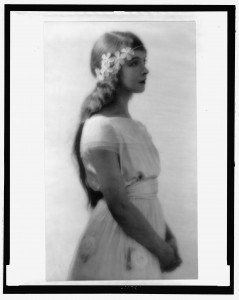
Lillian Gish portrait, 1922. Courtesy of the Library of Congress.
When the biographical approach emphasizes the difference between Gish’s public persona and her private ambition, it invites us to see her demurral as a clever tactic. By identifying with “the weaker sex” she turns a low expectation of women to her own advantage. That Gish left behind such a large volume of paper makes this hypothesis extremely tempting. Not only have there been numerous published accounts of her life, but her papers, available through the New York Public Library, include personal correspondence, business documents, and scrapbooks spanning the years 1909-1992. In addition, her correspondence with Slide is available through the Margaret Herrick Library. These sorts of sources urge us to seek a more complicated woman behind the public star persona.
A different source might shift focus to the terms of public discourse and allow us to ask if these terms were as conventionally fixed as the search for the private woman can make it appear. For instance, the Paramount-Famous Players press book (which suggested stories for exhibitors to plant in local papers) provides not one but two different ways to promote Remodelling Her Husband, the famous actress’s directorial debut. The first approach resembles the above-quoted Photoplay and Moving Picture Magazine articles, emphasizing Lillian’s “delicate physique” and her decision to abandon directing as too rigorous an endeavor. The second strategy, however, foregrounds her “prowess” and presents Dorothy as cajoling Lillian into the director’s chair. The studio publicity department thus promoted directing as something women might encourage their sisters to do while at the same time presenting women directors as an aberration in a profession that required masculine strength and discipline. How this apparently contradictory message played itself out in the trade press and the nation’s newspapers wants further explanation.
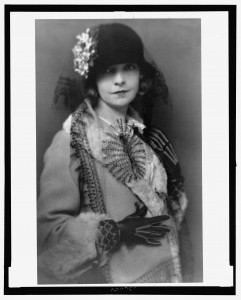
Lillian Gish in New York, 1922. Courtesy of the Library of Congress.
One could also take Gish’s remarks literally. After all, she advocates what would become the normative division of labor—women act, men direct—at a time when it was not clear that these work rules would, in fact, prevail. Similarly, while her praise of Griffith’s genius helped to ensure that her own contributions would be central to the story of American motion pictures, such veneration also promoted a particular version of historical events. By all accounts, Gish relished the role of spokesperson for silent film, and perhaps more work should consider her role as historian, critic, and theorist. Certainly Antonia Lant and Ingrid Periz aim to encourage such consideration by including Gish’s Encyclopedia Britannica article, “A Universal Language,” in their collection of women’s writing about the first fifty years of cinema. Echoes of Gish’s argument in that piece may be found in her less-known 1930 essay, “In Defense of the Silent Film.” With its conclusion that “Until the cinema returns from its prodigal excursion into sound it cannot expect to resume its logical development as an independent art” (230), the essay invites comparison with classic laments about the transition to sound from such filmmakers and film theorists as Bela Balazs, Rudolf Arnheim, Sergei Eisenstein, Vsevolod Pudovkin, and Grigori Alexandrov. In the essay, Gish writes with authority from her experience as an actor and names a wide range of directors she considers important—all of them men.
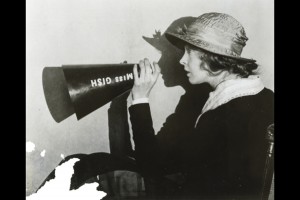
Lillian Gish with megaphone. Private Collection.
Bibliography
Acker, Ally. Reel Women: Pioneers of the Cinema, 1896 to the Present. New York: Continuum, 1991.
Affron, Charles. Lillian Gish: Her Legend, Her Life. New York: Scribner 2001.
------. “A Universal Language.” Rpt. in Red Velvet Seat: Women’s Writing on the First Fifty Years of Cinema. Eds. Antonia Lant and Ingrid Periz. London and New York: Verso, 2006. 200-202. [Originally published in The Theater and Motion Pictures: A Selections of Articles from the New 14th Edition of the Encyclopedia Britannica. New York and London: Encyclopaedia Britannica, 1929-33, 33-34.]
Gish, Lillian. “In Defense of the Silent Film.” Revolt of the Arts. Ed. Oliver M. Sayler. New York: Bretano’s, 1930. 225–30.
Gish, Lillian and Ann Pinchot. Lillian Gish: The Movies, Mr. Griffith, and Me. Englewood Cliffs: Prentice-Hall, 1969.
Hall, Gladys. “Lights! Says Lillian!” Motion Picture Magazine (April–May 1920): 30-31, 102.
Patterson, Ada. “The Gish Girls Talk About Each Other.” Photoplay (June 1921): 29.
Archival Paper Collections:
Anthony Slide Collection. Bowling Green State University.
Correspondence from Lillian Gish, 1962-1986 [with Lucy Kroll]. New York Public Library, Billy Rose Theatre Division.
D.W. Griffith papers, 1872-1969. Museum of Modern Art, Film Study Center.
Gish Film Theater Collection: Lillian Gish papers. Bowling Green State University.
Lillian Gish-actress/Anthony Slide, compiler. Anthony Slide Collection. Academy of Motion Picture Arts and Sciences, Margaret Herrick Library.
Lillian Gish letters and ephemera, 1936-1991. New York Public Library, Billy Rose Theatre Division.
Lillian Gish papers, 1920-1978. Library of Congress, Manuscript Division.
Lillian Gish papers and sound recordings, 1909-1992. New York Public Library, Billy Rose Theatre Division.
Lucy Kroll papers, 1908-1998. Library of Congress, Manuscript Division.
Reminiscences of Lillian Gish. Columbia University, Rare Book and Manuscript Library.
Samuel Stark. Theatre scrapbook collection, 1860-1950. Stanford University.
Filmography
A. Archival Filmograpy: Extant Film Titles:
1. Lillian Gish as Actress
Brutality. Dir.: D.W. Griffith (Biograph US 1912) cas.: Mae Marsh, Lionel Barrymore, Walter Miller, Lillian Gish, si, b&w, 35mm. Archive: Fundación Cinemateca Argentina, George Eastman Museum, Museum of Modern Art, Library and Archives Canada, Cinemateca Romana, Library of Congress.
The Burglar's Dilemma. Dir.: D.W. Griffith, sc.: Lionel Barrymore (Biograph US 1912) cas.: Lionel Barrymore, Henry Walthall, Adolph Lestina, Lillian Gish, si, b&w. Archive: George Eastman Museum, Museum of Modern Art, BFI National Archive.
A Cry For Help. Dir.: D.W. Griffith (Biograph US 1912) cas.: Lionel Barrymore, Lillian Gish, Walter Miller, si, b&w. Archive:Museum of Modern Art.
In the Aisles of the Wild. Dir.: D.W. Griffith (Biograph US 1912) cas.: Claire McDowell, Harry Carey, Lillian Gish, si, b&w. Archive: Museum of Modern Art, BFI National Archive.
The Musketeers of Pig Alley. Dir.: D.W. Griffith (Biograph US 1912) cas.: Elmer Booth, Alfred Paget, Lillian Gish, si, b&w, 35mm. Archive: Cinemateca do Museu de Arte Moderna, Cinémathèque Québécoise, Cineteca del Friuli, Danske Filminstitut, Münchner Stadtmuseum, Fundación Cinemateca Argentina, George Eastman Museum, Library of Congress, UCLA Film & Television Archive, Cinemateca Romana, Academy Film Archive, Svenska Filminstitutet, Cinémathèque Française, National Film and Sound Archive of Australia.
My Baby. Dir.: Frank Powell (Biograph US 1912) cas.: Mary Pickford, Henry Walthall, Eldean Stewart, W. Chrystie Miller, Lillian Gish, Alfred Paget, Madge Kirby, John T. Dillon, Walter Miller, Jack Pickford, Dorothy Gish, si, b&w, 35mm. Archive: George Eastman Museum, Library of Congress.
The New York Hat. Dir.: D.W. Griffith, st.: Anita Loos (Biograph US 1912) cas.: Mary Pickford, Lionel Barrymore, Dorothy Gish, Lillian Gish, si, b&w, 35mm. Archive: Cinémathèque Québécoise, Cinemateca do Museu de Arte Moderna, Svenska Filminstitutet, George Eastman Museum, Israel Film Archive/Jerusalem Cinematheque, Library of Congress, National Archives & Records Administration, Library and Archives Canada, BFI National Archive, UCLA Film & Television Archive, UC Berkeley Art Museum & Pacific Film Archive, Lobster Films.
The One She Loved. Dir.: D.W. Griffith (Biograph US 1912) cas.: Henry Walthall, Mary Pickford, Lionel Barrymore, Lillian Gish, si, b&w, 35mm. Archive: George Eastman Museum, Library of Congress.
The Painted Lady. Dir.: D.W. Griffith (Biograph US 1912) cas.: Blanche Sweet, Madge Kirby, Dorothy Gish, Lillian Gish, si, b&w, 16mm. Archive: Münchner Stadtmuseum, Fundación Cinemateca Argentina, George Eastman Museum, Library of Congress, UCLA Film & Television Archive, Cinemateca Romana, George Eastman Museum, Harvard Film Archive, National Film and Sound Archive of Australia.
So Near, Yet So Far. Dir.: D.W. Griffith (Biograph US 1912) cas.: Mary Pickford, Walter Miller, Lillian Gish, si, b&w, 35mm. Archive: George Eastman Museum, Library of Congress, BFI National Archive.
Two Daughters of Eve. Dir.: D.W. Griffith (Biograph US 1912) cas.: Lillian Gish, Claire McDowell, Henry Walthall, si, b&w. Archive: Museum of Modern Art, UCLA Film & Television Archive.
An Unseen Enemy. Dir.: D.W. Griffith, st.: Edward Acker (Biograph US 1912) cas.: Lillian Gish, Dorothy Gish, si, b&w. Archive: Cinémathèque Française, Cineteca del Friuli, Danske Filminstitut, George Eastman Museum, Museum of Modern Art, EYE Filmmuseum, UCLA Film & Television Archive, Cinemateca Romana, Svenska Filminstitutet, BFI National Archive, Harvard Film Archive, Fundación Cinemateca Argentina.
The Blue or the Gray. Dir.: William Christy Cabanne (Biograph US 1913) cas.: Lillian Gish, Dorothy Gish, si, b&w. Archive: Museum of Modern Art.
The Conscience of Hassan Bey. Dir.: William Christy Cabanne (Biograph US 1913) cas.: Lillian Gish, William A. Carroll, si, b&w. Archive: Museum of Modern Art.
The House of Darkness. Dir.: D.W. Griffith (Biograph US 1913) cas.: Lionel Barrymore, Claire McDowell, Lillian Gish, si, b&w. Archive: Museum of Modern Art, BFI National Archive, UCLA Film & Television Archive, Harvard Film Archive, Academy Film Archive.
Just Gold. Dir.: D.W. Griffith (Biograph US 1913) cas.: Lionel Barrymore, Lillian Gish, Alfred Paget, Charles H. West, Joseph McDermott, Kate Bruce, Charles Mailes, Dorothy Gish, si, b&w. Archive: Münchner Stadtmuseum, Museum of Modern Art.
The Lady and the Mouse. Dir.: D.W. Griffith (Biograph US 1913) cas.: Henry Walthall, Lillian Gish, Lionel Barrymore, Dorothy Gish, si, b&w. Archive: George Eastman Museum, Münchner Stadtmuseum, Fundación Cinemateca Argentina, Museum of Modern Art, Cinemateca Romana, BFI National Archive.
The Left-Handed Man. Dir.: D.W. Griffith (Biograph US 1913) cas.: Lillian Gish, Harry Carey, Charles West, si, b&w. Archive: Museum of Modern Art.
A Misunderstood Boy. Dir.: D.W. Griffith (Biograph US 1913) cas.: Lillian Gish, Lionel Barrymore, Kate Bruce, Robert Harron, Charles Hill Mailes, Alfred Paget, si, b&w, 35mm. Archive: UCLA Film & Television Archive.
The Mothering Heart. Dir.: D.W. Griffith, aut.: Hazel H. Hubbard (Biograph US 1913) cas.: Lillian Gish, Walter Miller, Viola Barry, Kate Bruce, Josephine Crowell, si, b&w. Archive: Cineteca del Friuli, Münchner Stadtmuseum, Fundación Cinemateca Argentina, George Eastman Museum, Museum of Modern Art, UCLA Film & Television Archive, Cinemateca Romana, Academy Film Archive, Svenska Filminstitutet, BFI National Archive.
Oil and Water. Dir.: D.W. Griffith (Biograph US 1913) cas.: Blanche Sweet, Henry Lionel Barrymore, Lillian Gish, si, b&w. Archive: Cineteca del Friuli, BFI National Archive, UCLA Film & Television Archive.
The Madonna of the Storm. Dir.: Alfred Paget (Biograph US 1913) cas.: Lillian Gish, Harry Carey, Charles Hill Mailes, si, b&w. Archive: Museum of Modern Art.
A Modest Hero. Dir.: Dell Henderson, sc.: George Hennessy (Biograph US 1913) cas.: Lillian Gish, Walter Miller, Charles Hill Mailes, si, b&w. Archive: BFI National Archive, Museum of Modern Art.
So Runs the Way. Dir.: W. Christy Cabanne (Biograph US 1913) cas.: Reggie Morris, W.C. Robinson, Kate Toncray, Joseph McDermott, Lillian Gish, si, b&w. Archive: Museum of Modern Art.
The Stolen Bride. Dir.: Tony O’Sullivan (Biograph US 1913) cas.: Harry Carey, Claire McDowell, Blanche Sweet, Lillian Gish, si, b&w. Archive: Museum of Modern Art.
A Timely Interception. Dir.: D.W. Griffith (Biograph US 1913) cas.: Lillian Gish, Lionel Barrymore, W. Chrystie Miller, William J. Butler, Robert Harron, Mae Marsh, Joseph McDermott, Walter Miller, Alfred Paget, si, b&w. Archive: Museum of Modern Art, Academy Film Archive.
The Unwelcome Guest. Dir.: D.W. Griffith (Biograph US 1913) cas.: Mary Pickford, W. Chrystie Miller, Charles Hill Mailes, Claire McDowell, Lillian Gish, si, b&w, 35mm. Archive: George Eastman Museum, Library of Congress, UCLA Film & Television Archive, Deutsches Filminstitut.
A Woman in the Ultimate. Dir.: Dell Henderson (Biograph US 1913) cas.: Lillian Gish, Charles Hill Mailes, Henry B. Walthall, si, b&w. Archive: Museum of Modern Art.
The Battle of Elderbush Gulch. Dir./sc.: D.W. Griffith (Biograph US 1913/4) cas.: Mae Marsh, Robert Harron, Lillian Gish, si, b&w, 35mm. Archive: Fondazione Cineteca di Bologna, Cineteca del Friuli, Münchner Stadtmuseum, Fundación Cinemateca Argentina, George Eastman Museum, Library of Congress, Museum of Modern Art, UCLA Film & Television Archive, Academy Film Archive, UC Berkeley Art Museum & Pacific Film Archive, Deutsche Kinemathek.
The Battle of the Sexes. Dir.: D.W. Griffith, sc. Daniel Carson Goodman (Majestic Motion Picture Co. US 1914) cas.: Donald Crisp, Lillian Gish, Robert Harron, Mary Alden, Owen Moore, Fay Tincher, W.E. Lawrence, si, b&w, 35mm, 5 reels. Archive: George Eastman Museum.
Home, Sweet Home. Dir.: D.W. Griffith, sc.: D.W. Griffith and Harry E. Aitkin (Reliance US 1914) cas.: Henry Walthall, Lillian Gish, Dorothy Gish, Mae Marsh, si, b&w. Archive: Cinémathèque Royale de Belgique, Cineteca del Friuli, Museum of Modern Art, UCLA Film & Television Archive, Academy Film Archive, Danske Filminstitut, National Film and Sound Archive of Australia.
Judith of Bethulia/Her Condoned Sin. Dir.: D.W. Griffith, st.: Thomas Bailey (Biograph US 1914) cas.: Lillian Gish, Blanche Sweet, Henry Walthall, Robert Harron, Kate Bruce, si, b&w, 35mm, 4 reels. Archive: Cinémathèque Royale de Belgique, Svenska Filminstitutet , Cineteca del Friuli, George Eastman Museum, Museum of Modern Art, Cineteca Nazionale, ISL, UCLA Film & Television Archive, Academy Film Archive, Danske Filminstitut, Harvard Film Archive, Deutsche Kinemathek, National Film and Sound Archive of Australia, Jugoslovenska Kinoteka, Lobster Films.
Lord Chumley. Dir.: James Kirkwood (Biograph US 1914) cas.: Henry Walthall, Lillian Gish, Mary Alden, Charles Mailes, Walter Miller, si, b&w. Archive: Cineteca del Friuli.
Man’s Enemy. Dir.: Frank Powell (Klaw and Erlanger US 1914) cas.: Franklin Ritchie, Lillian Gish, si, b&w. Archive: Cineteca del Friuli, Library of Congress, Museum of Modern Art.
The Sisters/A Duel for Love. Dir.: W. Christy Cabanne (Majestic US 1914) cas.: Lillian Gish, Dorothy Gish, W.E. Lawrence, Elmer Clifton, si, b&w, 35mm. Archive: Library of Congress.
The Birth of a Nation. Dir.: D.W. Griffith, sc.: D.W. Griffith, Frank E. Woods, st.: Thomas Dixon (David W. Griffith Corp US 1915) cas.: Lillian Gish, Henry Walthall, Mae Marsh, si, b&w, 35mm, 12 reels. Archive: Bulgarska Nacionalna Filmoteka, Fondazione Cineteca Italiana, Cinémathèque Royale de Belgique, Cinemateca Brasileira, Cinemateca do Museu de Arte Moderna, Danske Filminstitut, National Film and Sound Archive of Australia, Cineteca del Friuli, Deutsches Filminstitut, Münchner Stadtmuseum, Filmoteka Narodowa, George Eastman Museum, Gosfilmofond, Library of Congress, Museum of Modern Art, BFI National Archive, EYE Filmmuseum, Österreichisches Filmmuseum, Cinemateca Romana, Cinémathèque Québécoise, Cinemateca Nacional de Angola, Norwegian Film Institute, UCLA Film & Television Archive, Academy Film Archive, Filmoteca Española, Deutsches Filminstitut, Svenska Filminstitutet , Harvard Film Archive, Jugoslovenska Kinoteka, Cinémathèque Française.
Captain Macklin. Dir.: John B. O'Brien, sc.: Russell E. Smith (Majestic US 1915) cas.: Jack Conway, Spottiswoode Aitken, Lillian Gish, si, b&w, 35mm, 4 reels. Archive: Library of Congress.
Enoch Arden. Dir.: W. Christy Cabanne (Majestic US 1915) cas.: Lillian Gish, Wallace Reid, Alfred Paget, D.W. Griffith, Mildred Harris, si, b&w, 35mm, 4 reels. Archive: George Eastman Museum, Library of Congress, UCLA Film & Television Archive.
The Lily and the Rose. Prod.: D.W. Griffith, dir.: Paul Powell, st.: Granville Warwick, adp.: Paul Powell (Fine Arts Film Co. US 1915) cas.: Lillian Gish, Wilfred Alden, Wilfred Lucas, Rozsika Dolly, Loyola O’Connor, Cora Drew, Elmer Clifton, Mary Alden, William Hinckley, si, b&w, 35mm, 5 reels. Archive: Library of Congress.
The Children Pay. Dir.: Lloyd Ingraham, sc.: Frank E. Woods (Fine Arts Film Co. US 1916) cas.: Lillian Gish, Violet Wilkie, Keith Armour, si, b&w, 5 reels. Archive: Danske Filminstitut.
A House Built Upon Sand. Dir. Edward Morrissey, sc.: Mary H. O’Connor (Fine Arts Film Co. US 1916) cas.: Lillian Gish, Roy Stewart, William H. Brown, si, b&w, 35mm, 5 reels. Archive: Library of Congress.
Intolerance. Dir./sc.: D.W. Griffith (D. W. Griffith; Wark Producing Corp. US 1916) cas: Lillian Gish, Mae Marsh, Robert Harron, Margery Wilson, si, b&w, 35mm. Archive: Bulgarska Nacionalna Filmoteka, Cinémathèque Québécoise, Cinémathèque Royale de Belgique, Svenska Filminstitutet , National Film and Sound Archive of Australia, Cineteca del Friuli, Münchner Stadtmuseum, Filmoteka Narodowa, George Eastman Museum, Gosfilmofond, Library of Congress, Museum of Modern Art, BFI National Archive, EYE Filmmuseum, Österreichisches Filmmuseum, Cineteca Nazionale, Fondazione Cineteca Italiana, Cinemateca Romana, UCLA Film & Television Archive, Academy Film Archive, Filmoteca Española, Harvard Film Archive, Library and Archives Canada, Danske Filminstitut, Museo Nazionale del Cinema, UC Berkeley Art Museum & Pacific Film Archive, Jugoslovenska Kinoteka, Anthology Film Archives, Lobster Films.
Sold For Marriage. Dir.: W. Christy Cabanne, st.: William E. Wing (Fine Arts Film Co. US 1916) cas.: Lillian Gish, Frank Bennett, A.D. Sears, Pearl Elmore, Curt Rehfelt, William E. Lowery, Fred Burns, William Siebert, Frank Brownlee, si, b&w, 35mm. Archive: Cineteca del Friuli, Library of Congress, George Eastman Museum.
The Greatest Thing in Life. Dir.: D.W. Griffith, sc./st.: Captain Victor Marier (D.W. Griffith/Artcraft US 1918) cas.: Lillian Gish, Robert Harron, Adolphe Lestina, si, b&w. Archive: BFI National Archive.
Hearts of the World. Prod./dir.: D.W. Griffith, sc.: M. Gaston de Tolignac (D. W. Griffith US 1918) cas.: Lillian Gish, Robert Harron, si, b&w, 13 reels. Archive: Cinémathèque Royale de Belgique, Cinemateca Brasileira, Cineteca del Friuli, Museum of Modern Art, BFI National Archive, EYE Filmmuseum, Cinemateca Romana, UCLA Film & Television Archive, Academy Film Archive, George Eastman Museum, Harvard Film Archive, Cinémathèque Française, National Film and Sound Archive of Australia, Lobster Films.
Broken Blossoms. Prod./dir.: D.W. Griffith (D.W. Griffith US 1919) cas.: Lillian Gish, Richard Barthelmess, si, b&w, 35mm, 6 reels. Archive: Bulgarska Nacionalna Filmoteka, Cinémathèque Québécoise, Cinémathèque Royale de Belgique, Cinemateca Brasileira, Cinemateca do Museu de Arte Moderna, Cineteca del Friuli, Münchner Stadtmuseum, Filmoteka Narodowa, George Eastman Museum, Museum of Modern Art, BFI National Archive, Gosfilmofond, Cineteca Nazionale, Cinemateca Romana, UCLA Film & Television Archive, Academy Film Archive, Harvard Film Archive, Danske Filminstitut, National Film and Sound Archive of Australia, Jugoslovenska Kinoteka.
The Greatest Question. Prod./dir.: D.W. Griffith, sc.: S.E.V. Taylor, st.: William Hale (D. W. Griffith US 1919) cas: Lillian Gish, Robert Harron, si, b&w. Archive: Museum of Modern Art, Cinémathèque Royale de Belgique, George Eastman Museum, Academy Film Archive.
A Romance of Happy Valley. Dir.: D.W. Griffith, sc.: Captain Victor Marier (D. W. Griffith US 1919) cas: Lillian Gish, Robert Harron, si, b&w. Archive: Cinémathèque Royale de Belgique, Cineteca del Friuli, Museum of Modern Art, Gosfilmofond, National Film and Sound Archive of Australia.
True Heart Susie. Prod/dir.: D.W. Griffith, st.: Marian Fremont (D.W. Griffith; Griffith’s Short Story series US 1919) cas: Lillian Gish, Robert Harron, si, b&w. Archive: Cinémathèque Royale de Belgique, Cinemateca Brasileira, Cinemateca do Museu de Arte Moderna, Cineteca del Friuli, Museum of Modern Art, BFI National Archive, EYE Filmmuseum, Cinemateca Romana, UCLA Film & Television Archive, George Eastman Museum, Danske Filminstitut, Harvard Film Archive.
Way Down East. Dir.: D.W. Griffith, sc.: Anthony Paul Kelly, cost.: Lucy Duff-Gordon (D.W. Griffith, Inc. US 1920) cas.: Lillian Gish, Richard Barthelmess, si, b&w. Archive: Library of Congress, Cinémathèque Royale de Belgique, Fondazione Cineteca di Bologna, Cineteca del Friuli, Filmoteka Narodowa, George Eastman Museum, Museum of Modern Art, BFI National Archive, EYE Filmmuseum, Gosfilmofond, Cineteca Nazionale, Fondazione Cineteca Italiana, Cinemateca Romana, UCLA Film & Television Archive, Academy Film Archive, Danske Filminstitut, Svenska Filminstitutet , Harvard Film Archive.
Orphans of the Storm. Prod./dir: D.W. Griffith, sc.: Marquis de Trolignac (D.W. Griffith, Inc. US 1921) cas.: Lillian Gish, Dorothy Gish, si, b&w, 14 reels. Archive: Bulgarska Nacionalna Filmoteka, Cinémathèque Royale de Belgique, Svenska Filminstitutet , Filmoteka Narodowa, Museum of Modern Art, UCLA Film & Television Archive, Gosfilmofond, Cineteca Nazionale, Fondazione Cineteca Italiana, Cinemateca Romana, Cinémathèque Québécoise, George Eastman Museum, Academy Film Archive, Filmoteca Española, BFI National Archive, National Film and Sound Archive of Australia.
The White Sister. Dir.: Henry King, sc.: George V. Hobart, Charles E. Whittaker (Inspiration Pictures US 1923) cas.: Lillian Gish, Ronald Colman, si, b&w, 35mm. Archive: Filmoteca Española, UC Berkeley Art Museum & Pacific Film Archive.
Romola. Dir.: Henry King, sc.: Will M. Ritchey (Inspiration Pictures US 1925) cas.: Lillian Gish, Dorothy Gish, William Powell, Ronald Colman, si, b&w, 35mm. Archive: Museum of Modern Art, UCLA Film & Television Archive, Cinémathèque Française.
La Bohème. Dir.: King Vidor, st.: Fred De Gresac (Metro-Goldwyn-Mayer Pictures US 1926) cas.: Lillian Gish, John Gilbert, Renée Adorée, si, b&w. Archive: Cinémathèque Royale de Belgique, EYE Filmmuseum, George Eastman Museum, Museo Nazionale del Cinema, National Film and Sound Archive of Australia.
Annie Laurie. Dir.: John S. Robertson, sc.: Josephine Lovett (Metro-Goldwyn-Mayer Pictures US 1927) cas.: Lillian Gish, Norman Kerry, si, b&w, 35mm. Archive: Library of Congress, UCLA Film & Television Archive, BFI National Archive.
The Scarlet Letter. Dir.: Victor Seastrom, sc.: Frances Marion (Metro-Goldwyn-Mayer Pictures US 1927) cas.: Lillian Gish, Lars Hanson, Henry B. Walthall, si, b&w, 35mm. Archive: Cinémathèque Royale de Belgique, Svenska Filminstitutet , George Eastman Museum, Library of Congress, Cineteca Nazionale, UCLA Film & Television Archive, BFI National Archive, UC Berkeley Art Museum & Pacific Film Archive, Danske Filminstitut, National Film and Sound Archive of Australia, Jugoslovenska Kinoteka.
The Wind. Dir.: Victor Seastrom, sc./adp.: Frances Marion (Metro-Goldwyn-Mayer Pictures US 1928) cas.: Lillian Gish, Lars Hanson, si, b&w, 35mm. Archive: Cineteca Nazionale, Cinémathèque Royale de Belgique, Cinemateca Romana, Cineteca del Friuli, Filmoteca UNAM, George Eastman Museum, BFI National Archive, Danske Filminstitut, Svenska Filminstitutet , Cinémathèque Française, National Film and Sound Archive of Australia, Jugoslovenska Kinoteka.
The Enemy. Dir.: Fred Niblo, sc.: Agnes Christine Johnston, Willis Goldbeck (Metro-Goldwyn-Mayer US 1928) cas.: Lillian Gish, Ralph Forbes, Ralph Emerson, si, b&w, 35mm. Archive: Library of Congress.
B. Filmography: Non-Extant Film Titles:
1. Lillian Gish as Actress
Gold and Glitter, 1912; During the Round Up, 1913; An Indian's Loyalty, 1913; The Angel of Contention, 1914; The Folly of Anne, 1914; The Green-Eyed Devil, 1914; The Hunchback, 1914; The Quicksands, 1914; The Rebellion of Kitty Belle, 1914; The Tear That Burned, 1914; The Lost House, 1915; Daphne and the Pirate, 1916; Diane of the Follies, 1916; An Innocent Magdalene, 1916; Pathways of Life, 1916; Souls Triumphant, 1917; The Great Love, 1918; “Liberty Bond Short,” 1918.
2. Lillian Gish as Director and Screenwriter
Remodelling Her Husband, 1920.
C. DVD Sources:
Griffith Masterworks: Biograph Shorts (1908-1914). DVD. (Kino Video US 2002)
D.W. Griffith Years of Discovery, 1909-1913. DVD. (Image Entertainment US 2002)
D. W. Griffith Monumental Epics. DVD. (Eureka Entertainment UK 2002)
The Actors: Rare Films of Lillian Gish, vol. 1 & 2. DVD. (Classic Video Streams US 2002)
Judith of Bethulia. DVD. (Alpha Video US 2012)
The Battle of Elderbush Gulch. DVD. (VCI Entertainment US 2003)- on The Great Train Robbery 100th Anniversary Special Edition
Griffith Masterworks: The Birth of a Nation. DVD. (Kino Video US 2002)
The Birth of a Nation. DVD. (Kino Lorber US 2011)
The Birth of a Nation. DVD. (Eureka Entertainment US 2013)
Sold for Marriage. DVD. (Grapevine US 2005)
Intolerance. DVD. (Kino US 2002)
Intolerance. DVD. (Delta Entertainment US 2004)
Hearts of the World. DVD. (Alpha Video US 2014)
Broken Blossoms. DVD. (Kino Video US 2002)
Broken Blossoms. DVD. (Kino International US 2001)
Broken Blossoms. DVD. (Alpha Video US 2005)
True Heart Susie. DVD. (Flicker Alley US 2015)
True Heart Susie. DVD. (Grapevine US 2005)
The Greatest Question. DVD. (Kino International US 2008)
Way Down East. DVD. (Kino International US 2008)
Way Down East. DVD. (Alpha Video US 2004)
Orphans of the Storm. DVD. (Kino US 2002)
Orphans of the Storm. DVD. (Alpha Video US 2003)
Orphans of the Storm. DVD. (Delta Entertainment US 2004)
The White Sister. DVD. (Warner Archive Collection US 2011)
The White Sister. DVD. (Grapevine Video US 2006)
Romola. DVD. (Grapevine Video US 2015)
La Bohème. DVD. (Warner Archive Collection US 2010)
The Wind. DVD. (Bach Films France 2013)
A Romance of Happy Valley. DVD. (Alpha Video US 2015)
The Scarlet Letter. DVD. (Alpha Video US 2003)
D. Streamed Media:
The Birth of a Nation (1915) is streaming online via Kanopy
Intolerance (1916) is streaming online via Kanopy
Intolerance (1916) is streaming online via Amazon Prime
Intolerance (1916) is streaming online via the Internet Archive
Broken Blossoms (1919) is streaming online via Kanopy
Broken Blossoms (1919) is streaming online via Amazon Video
Broken Blossoms (1919) is streaming online via the Internet Archive
Way Down East (1920) is streaming online via Kanopy
Way Down East (1920) is streaming online via Amazon Video
Way Down East (1920) is streaming online via the Internet Archive
The Burglar's Dilemma (1912) is streaming online via Amazon Video
Orphans of the Storm (1921) is streaming online via Kanopy
Orphans of the Storm (1921) is streaming online via the Internet Archive
An Unseen Enemy (1911) is streaming online via Amazon Video
The Painted Lady (1911) is streaming online via Amazon Video
The Musketeers of Pig Alley (1911) is streaming online via Amazon Video
The Musketeers of Pig Alley (1911) is streaming online via the Internet Archive
The Mothering Heart (1912) is streaming online via Amazon Video
The Mothering Heart (1912) is streaming online via the Internet Archive
Hearts of the World (1918) is streaming online via Amazon Prime
Home, Sweet Home (1914) is streaming online via the Internet Archive
The Greatest Question (1919) is streaming online via the Internet Archive
True Heart Susie (1919) is streaming online via the Internet Archive
Credit Report
Lillian Gish’s filmography was primarily culled from Charles Affron’s chronological record in Lillian Gish, the FIAF International database, the American Film Index (AFI), the Film International Index (FII), Paul Spehr, and the Braff papers on short films in silent cinema. That said, there are still some inconsistencies in Lillian Gish’s filmography. Many of her short films from the 1910s can’t be confirmed in the AFI index, which focuses on features and often omits shorts. Format and reel counts have occasionally been omitted when the data was inconsistent as different archives have different material. As with many films released at the end of the year, dates are inconsistent in different sources. For instance, The Enemy is listed as both 1927 and 1928. Its New York opening was December 1927, while its general release opening was February 1928. The copy at the MGM archives is incomplete. Lillian Gish’s filmography is also unique because of the unusually large number of writers who used a nom de plume on her films, including Granville Warwick (D. W. Griffith), Captain Victor Marier (Griffith with S. E. V. Taylor), and Dorothy Elizabeth Carter (the Gish sisters who cowrote Remodelling Her Husband). Finally, on the FIAF database a film titled The All Star Family in Distress: A Film Cutter’s Nightmare with Gish, Chaplin, and Gloria Swanson is listed as being held in the UCLA archives. However, the nature of the material can’t be confirmed and it is not certain that Lillian Gish even appears in the footage. Several online sources list Pathways of Life as extant and held in the UCLA Archives. FIAF Treasures (which also says the film is held in the Academy Film Archives) and the UCLA online catalogue list the year of the film held as 1914. With no other information listed, more research needs to be done to see whether or not this is Gish's Pathways of Life.
Citation
Cooper, Mark Garrett. "Lillian Gish." In Jane Gaines, Radha Vatsal, and Monica Dall’Asta, eds. Women Film Pioneers Project. New York, NY: Columbia University Libraries, 2013. <https://doi.org/10.7916/d8-9vgd-hd51>

